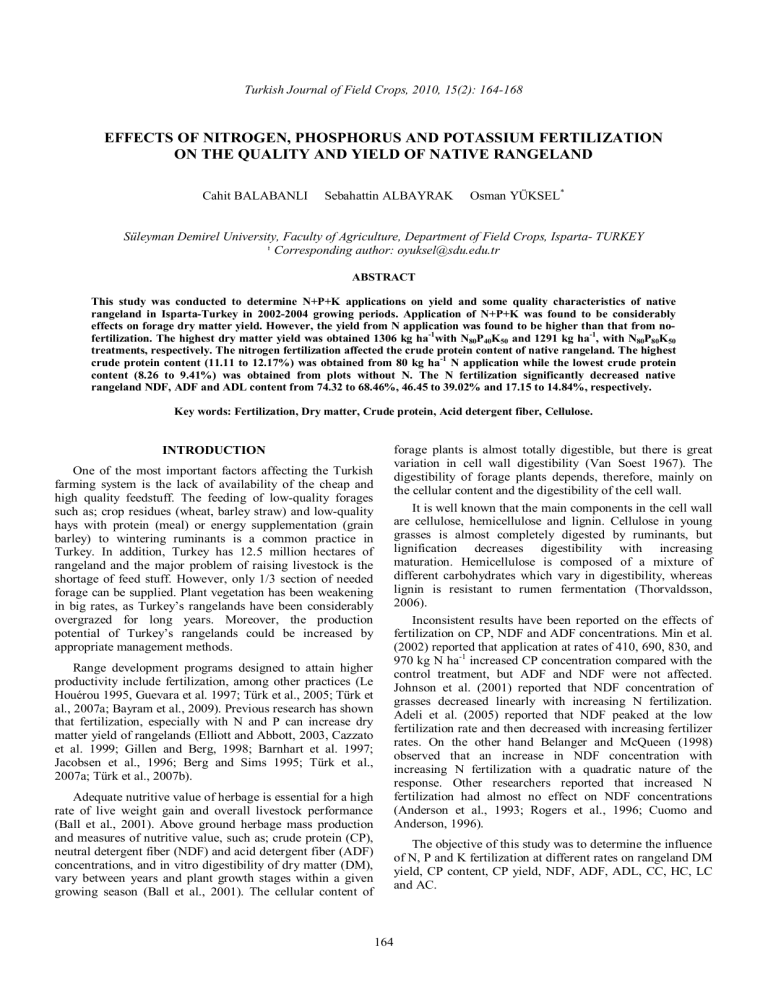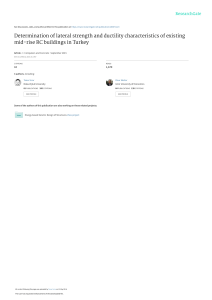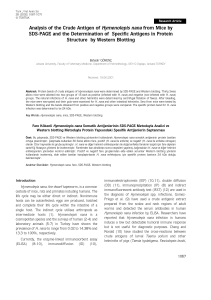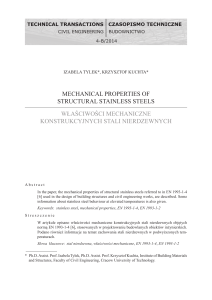
Turkish Journal of Field Crops, 2010, 15(2): 164-168
EFFECTS OF NITROGEN, PHOSPHORUS AND POTASSIUM FERTILIZATION
ON THE QUALITY AND YIELD OF NATIVE RANGELAND
Cahit BALABANLI
Sebahattin ALBAYRAK
Osman YÜKSEL*
Süleyman Demirel University, Faculty of Agriculture, Department of Field Crops, Isparta- TURKEY
*Corresponding author: oyuksel@sdu.edu.tr
ABSTRACT
This study was conducted to determine N+P+K applications on yield and some quality characteristics of native
rangeland in Isparta-Turkey in 2002-2004 growing periods. Application of N+P+K was found to be considerably
effects on forage dry matter yield. However, the yield from N application was found to be higher than that from nofertilization. The highest dry matter yield was obtained 1306 kg ha-1with N80P40K50 and 1291 kg ha-1, with N80P80K50
treatments, respectively. The nitrogen fertilization affected the crude protein content of native rangeland. The highest
crude protein content (11.11 to 12.17%) was obtained from 80 kg ha-1 N application while the lowest crude protein
content (8.26 to 9.41%) was obtained from plots without N. The N fertilization significantly decreased native
rangeland NDF, ADF and ADL content from 74.32 to 68.46%, 46.45 to 39.02% and 17.15 to 14.84%, respectively.
Key words: Fertilization, Dry matter, Crude protein, Acid detergent fiber, Cellulose.
forage plants is almost totally digestible, but there is great
variation in cell wall digestibility (Van Soest 1967). The
digestibility of forage plants depends, therefore, mainly on
the cellular content and the digestibility of the cell wall.
It is well known that the main components in the cell wall
are cellulose, hemicellulose and lignin. Cellulose in young
grasses is almost completely digested by ruminants, but
lignification decreases digestibility with increasing
maturation. Hemicellulose is composed of a mixture of
different carbohydrates which vary in digestibility, whereas
lignin is resistant to rumen fermentation (Thorvaldsson,
2006).
Inconsistent results have been reported on the effects of
fertilization on CP, NDF and ADF concentrations. Min et al.
(2002) reported that application at rates of 410, 690, 830, and
970 kg N ha-1 increased CP concentration compared with the
control treatment, but ADF and NDF were not affected.
Johnson et al. (2001) reported that NDF concentration of
grasses decreased linearly with increasing N fertilization.
Adeli et al. (2005) reported that NDF peaked at the low
fertilization rate and then decreased with increasing fertilizer
rates. On the other hand Belanger and McQueen (1998)
observed that an increase in NDF concentration with
increasing N fertilization with a quadratic nature of the
response. Other researchers reported that increased N
fertilization had almost no effect on NDF concentrations
(Anderson et al., 1993; Rogers et al., 1996; Cuomo and
Anderson, 1996).
INTRODUCTION
One of the most important factors affecting the Turkish
farming system is the lack of availability of the cheap and
high quality feedstuff. The feeding of low-quality forages
such as; crop residues (wheat, barley straw) and low-quality
hays with protein (meal) or energy supplementation (grain
barley) to wintering ruminants is a common practice in
Turkey. In addition, Turkey has 12.5 million hectares of
rangeland and the major problem of raising livestock is the
shortage of feed stuff. However, only 1/3 section of needed
forage can be supplied. Plant vegetation has been weakening
in big rates, as Turkey’s rangelands have been considerably
overgrazed for long years. Moreover, the production
potential of Turkey’s rangelands could be increased by
appropriate management methods.
Range development programs designed to attain higher
productivity include fertilization, among other practices (Le
Houérou 1995, Guevara et al. 1997; Türk et al., 2005; Türk et
al., 2007a; Bayram et al., 2009). Previous research has shown
that fertilization, especially with N and P can increase dry
matter yield of rangelands (Elliott and Abbott, 2003, Cazzato
et al. 1999; Gillen and Berg, 1998; Barnhart et al. 1997;
Jacobsen et al., 1996; Berg and Sims 1995; Türk et al.,
2007a; Türk et al., 2007b).
Adequate nutritive value of herbage is essential for a high
rate of live weight gain and overall livestock performance
(Ball et al., 2001). Above ground herbage mass production
and measures of nutritive value, such as; crude protein (CP),
neutral detergent fiber (NDF) and acid detergent fiber (ADF)
concentrations, and in vitro digestibility of dry matter (DM),
vary between years and plant growth stages within a given
growing season (Ball et al., 2001). The cellular content of
The objective of this study was to determine the influence
of N, P and K fertilization at different rates on rangeland DM
yield, CP content, CP yield, NDF, ADF, ADL, CC, HC, LC
and AC.
164
ratios were calculated. Dry matter yield of each plot was
calculated through the values of green forage production and
dry-weight percentage. Crude protein content was
determined by micro-Kjeldhal (Nx6.25) (Technicon, 1977).
Pasture samples were immediately dried, weighed, and
ground for determinations of NDF and ADF concentrations.
The ANKOM Fiber Analyzer (Model No: ANKOM220,
Ankom Technology, Fairport, NY) and ANKOM F57 filter
bags were used for NDF, ADF and ADL analysis (Anon.
2006). Cellulose, hemicellulose and lignin content of
materials were calculated by using NDF, ADF and ADL
values. Samples were burned at 600 oC in an ash-oven to
determine crude ash. Crude ash ratios were determined from
the ratio of sample weights before and after burning.
MATERIALS AND METHODS
This study was conducted at Isparta (37o 45' N, 30o 33' E,
elevation 1035 m) where located on the Mediterranean region
of the Turkey in the period of 2002-2004. Total precipitation
and average temperature were found to be 574.2 mm and
8.46 oC in 2002-2003; 544.7 mm and 8.49 oC in 2003-2004;
519.9 mm and 8.38 oC in long years, respectively (Table 1).
Precipitation (mm)
Temperature (°C)
Long Term
2002-2003
2003-2004
Long Term
2002-2003
2003-2004
Table 1. Monthly precipitation and mean temperature in the
experimental area.
45.4
94.3
84.8
75.5
60.6
68.4
55.5
35.4
519.9
-
38.0
99.2
23.2
106.8
48.0
133.2
89.5
36.3
574.2
-
13.7
151.6
201.4
49.9
4.9
76.6
20.8
25.8
544.7
-
7.7
3.6
1.7
2.7
5.7
10.6
15.4
19.6
8.38
8.2
0.9
6.3
0.2
3.9
9.7
17.1
21.4
8.46
7.4
2.5
0.7
2.9
7.6
10.9
15.5
20.4
8.49
Months
November
December
January
February
March
April
May
June
Total
Mean
A randomized complete block experimental design was
used in the study. The data was analyzed with Repeated
Measures Analysis of Variance using SAS program (SAS
1998). Means were separated by LSD at the 5 % level of
significance.
RESULTS AND DISCUSSION
There was a significant yield response to fertilization.
Application of N+P+K affect forage dry matter yield. Yield
from N application was higher than that from no-fertilization.
The highest dry matter yield was obtained from N80P40K50
and N80P80K50 treatments (1306 and 1291 kg ha-1,
respectively) (Figure.1).
The major soil characteristics, based on the method
described by Rowell (1996) were found to be as follows; the
soil texture: Clay, organic matter ratio: 1.3%, total salt ratio:
0.2%, lime ratio: 7%, sulphur content: 11 mg kg-1,
extractable P content: 3.8 mg kg-1, exchangeable K content:
112 mg kg-1, pH: 7.2.
Fertilizer applications were Randomized Complete Block
assigned to 10 plots within each of 3 blocks. Each treatment
plot was dimension of 3m×4m (width and length) with a
distance of 1m between each plot. Treatments were repeated
in the same plot for 2003 and 2004. Nitrogen was applied as
ammonium nitrate (33.5-0-0), phosphorus was applied as
triple super phosphate (0-46-0) and potassium was applied as
potassium sulphate (0-0-52).
Combining the yield and protein data allowed the mean
crude protein yield to be calculated. For the control plots this
averaged 65.8 kg ha-1 over the two years (Figure 2). This
increased to 151.1 and 158.9 kg ha-1, respectively by
N80P40K50 and N80P80K50 treatments. On the other hand, the
plots without N had the lowest crude protein yield (65.8 to
77.5 kg ha-1) (Figure. 2).
Nitrogen fertilization affected the crude protein content of
native rangeland. The highest crude protein content (11.11 to
12.17%) was obtained from 80 kg ha-1 N application while
the lowest crude protein content (8.26 to 9.41%) was
obtained from plots without N (Table 2)
Ten different fertilizer combinations (N0P0K0, N0P0K50,
N0P40K50, N0P80K50, N40P0K50, N40P40K50, N40P80K50,
N80P0K50, N80P40K50 and N80P80K50) were utilized in the
present research. Fertilizers were broadcasted by hand and
then buried by a rake without disturbing the vegetation. Half
of the N and all of P and K were applied at the beginning of
November. The remaining N was applied at the beginning of
rapid growth period of vegetation (mid-March).
Dry matter (DM) yield, crude protein (CP) content, CP
yield, NDF, ADF, ADL, cellulose (CC), hemicellulose (HC),
lignin (LC), ash (AC) were investigated in experiment.
Herbaceous vegetation was annually harvested within
8.75 m2 area after ignoring 0.5 m area from all sides of the
plots when grass plants reached full flowering stage at the
beginning of June. Vegetation was hand clipped at ground
level. And then, green forage production per 8.75 m2 area
was recorded. Samples taken from each plot were oven-dried
at 70 C till they reach to constant weight and, dry weight
165
1400
Dry matter yield (kg ha -1)
1200
LSD= 36
1000
800
600
400
200
e
e
e
e
d
c
cd
b
a
ab
0
1
2
3
4
5
6
7
8
9
10
Figure 1. The means of dry matter yield (kg ha-1) of native rangeland in Mediterranean region, Turkey. Values with different columns
differ significantly at P<0.05.Treatments: 1. N0P0K0; 2. N0P0K50; 3. N0P40K50; 4. N0P80K50; 5. N40P0K50; 6. N40P40K50; 7.
N40P80K50; 8. N80P0K50; 9. N80P40K50; 10. N80P80K50.
Table 2. The means of CP, NDF, ADF, ADL, HC, CC, LC and AC % of native rangeland in Mediterranean region, Turkey. Values with
different columns differ significantly at P<0.05.
CP
NDF
ADF
ADL
AC
N– P – K
HC
CC
LC
0–0–0
0 – 0 – 50
0 – 40 – 50
0 – 80 – 50
40 – 0 – 50
40– 40 – 50
40– 80 – 50
80 – 0 – 50
80–40–5 0
80–80–50
LSD (%5)
8.26 d
8.28 d
9.67 c
9.41 cd
10.42 bc
10.63 bc
10.42 bc
11.11 ab
12.17 a
11.70 ab
1.40
74.32 a
74.04 ab
73.37 ab
74.04 ab
72.50 bc
71.45 cd
70.48 d
71.40 cd
69.72 de
68.46 e
1.78
46.45 a
46.04 a
45.53 a
45.34 a
44.00 b
43.42 b
42.88 c
41.73 d
40.00 e
39.02 f
0.75
17.15 a
17.02 ab
16.93 ab
16.90 ac
16.68 bd
16.49 cd
16.25 d
15.29 e
15.28 e
14.84 e
0.46
27.87
28.00
27.84
28.70
28.50
28.02
27.60
29.67
29.72
29.44
2.13
29.30 a
29.02 ab
28.60 ab
28.44 b
27.32 c
26.93 cd
26.63 cd
26.44 d
24.72 e
24.18 e
0.83
6.85 a
6.29 b
6.28 b
6.17 b
5.28 c
4.97 d
4.42 e
3.25 f
3.08 fg
2.77 g
0.35
10.30 e
10.73 d
10.65 d
10.73 d
11.40 c
11.52 c
11.83 b
12.04 ab
12.20 a
12.07 ab
0.26
180
Crude protein yield (kg ha -1)
160
140
LSD= 15.96
120
100
80
60
40
20
d
d
d
d
c
c
c
b
a
ab
0
1
2
3
4
5
6
7
8
9
10
Figure 2. The means of crude protein yield (kg ha-1) of native rangeland in Mediterranean region, Turkey. Values with different columns
differ significantly at P<0.05.Treatments: 1. N0P0K0; 2. N0P0K50; 3. N0P40K50; 4. N0P80K50; 5. N40P0K50; 6. N40P40K50; 7.
N40P80K50; 8. N80P0K50; 9. N80P40K50; 10. N80P80K50
166
The applications of N had significant effects on ADL.
The highest ADL values (between 16.90 and 17.15%) were
obtained from plots without N, while the lowest ADL
(14.84%) was obtained from N80P80K50-treatment. Wolf and
Boberfeld (2003) reported that the value of ADL increased
with increasing amounts of N, but the concentration of
energy decreased in tall fescue, this result is consistent with
our results.
N fertilization significantly decreased native rangeland
NDF, ADF and ADL content from 74.32 to 68.46%, 46.45 to
39.02% and 17.15 to 14.84%, respectively (Table 2). The
NDF, ADF and ADL concentrations of fertilized herbage
were significantly lower in plots with additions N+P than in
plots without added P. The NDF, ADF and ADL
concentrations were affected by N+K fertilization. Increasing
N fertilization decreased cellulose and lignin contents from
29.30 to 24.18% and 6.85 to 2.77% (Table 2). Cellulose and
lignin contents decreased from N+P and N+K fertilization.
However, application of N, P and K did not affect
hemicellulose content of native rangeland. Therefore,
changes in one of these fractions affect one or more of the
other fractions.
Fertilizer treatments significantly decreased lignin
content. Increasing N fertilization resulted in decreased lignin
content. Holubek et al. (1999) reported that non-fertilized
semi-natural grassland contained on average 5.50 to 6.08%
lignin while fertilized semi-natural grassland contained on
average 5.77 to 6.20% lignin. Lignin is indigestible plant
component, giving the plant cell wall its strength and water
impermeability.
The highest ash content was obtained from N80P40K50,
N80P80K50 and N80P0K50 treatments (12.20, 12.07 and 12.04%,
respectively) while the lowest ash content (10.3%) was
obtained from control plot (Table 2).
Ash ratio changed significantly with N and K, but it did
not vary significantly with P. This result was in accordance
with the result reported by Altin (1975).
Nitrogen fertilization increased DM yield. The highest
dry matter yield was obtained from N80P40K50 and N80P80K50.
This result is consistent with previous research that has
shown fertilizer was one of the most efficient methods to
improve DM production in native rangeland (Elliott and
Abbott 2003; Gillen and Berg, 1998; Barnhart et al. 1997;
Jacobsen et al., 1996; Berg and Sims 1995; Power 1985).
The effects of fertilizer treatments on hemicellulose
content were found no significant. Hemicellulose is long
chains of sugar compounds associated with plant cell walls.
Cellulose content was significantly influenced from
fertilizer treatments. The plots without N gave the higher
cellulose content than the plots with N. Grimes (1967), found
that the cellulose content was lower on N fertilized pastures
than on pastures not fertilized with N. The results found in
this study confirm the findings of Grimes (1967) for
cellulose. Archibeque et al. (2001) responded to increase N
with a decrease in cellulose and lignin levels in switchgrass,
this results in consistent with our results.
Crude protein production depends on dry matter yield in
treatments and crude protein concentration in plants, which
changes according to plant species. In fact, fertilizer affected
crude protein production and also botanical composition.
Therefore, the higher crude protein yield in this study might
be related to effects of fertilizer, which directly affects dry
matter yield.
Potassium and phosphorous fertilizers did not directly
affect the CP content. However, increasing N fertilization
resulted in an increased CP content. An increase in crude
protein content due to N or N+P+K applications has also
been reported in numerous studies (Rubio et al., 1996; Gillen
and Berg, 1998; Guevara et al., 1997).
CONCLUSIONS
The application of N, P and K fertilizer were considered
essential for optimum forage yield and quality of native
rangeland as the two year research conducted in
Mediterranean conditions of Turkey. The results from the
different N, P and K fertilizers applied in natural rangeland in
Mediterranean conditions of Turkey can be summarized as
follows: The increasing N fertilizer effects increasing yield of
DM and CP. This increasing yield level of DM and CP were
greater with P and K application. The application of N with
combination P+K reduced the percentage of NDF, ADF,
ADL, LC, CC and AC. The application of N with P+K was
found to be no considerable effect on HC.
The NDF concentration decreased with increasing N
fertilization. As found in this study, Johnson et al. (2001)
reported that the NDF concentration linearly decreased with
increasing N fertilization. Adeli et al. (2005) found that NDF
peaked at the low fertilization rate and then decreased with
increasing fertilizer rates. In contrast to our results, Rogers et
al. (1996) reported that increased N fertilization had only
marginally effect on the NDF concentration. Malhi et al.
(2004) found that effects of only P and K fertilizer on NDF
were no significant; this result is consistent with our results.
The ADF concentration in the native rangeland did not
vary significantly with the P and K fertilizer, but it changed
significantly with the N fertilizer. In plots without N, ADF
changed from 45.34 to 46.45%. The lowest ADF percentage
(39.02%) was determined in N80P80K50 treatment. This result
is similar to the work by Adeli et al. (2005) who reported that
maximum ADF concentration was obtained from low
fertilizer treatment.
167
LITERATURE CITED
Jacobsen J.S., S.H. Lorbeer, H.A.R. Houlton and G.R. Carlson.
1996. Nitrogen fertilization of dryland grasses in the Northern
Great Plains J. Range Manage. 49(4):340-345.
Johnson, R.C., B.A. Reiling, P. Mislevy, and M.B. Hall. 2001.
Effects of nitrogen fertilization and harvest date on yield,
digestibility, fiber, and protein fractions of tropical grasses. J.
Anim. Sci. 79: 2439–2448.
Le Houérou, H.N. 1995. Informe de las visitas a la Argentina:
Octubre-Noviembre 1992 y Setiembre-Noviembre 1995 (In
Spanish). IADIZA, Mendoza.
Malhi, S.S., H. Loeppky, B. Coulman, K. S. Gill, P. Curry and T.
Plews. 2004. Fertilizer nitrogen, phosphorus, potassium, and
sulphur effects on forage yield and quality of timothy hay in the
parkland region of Saskatchewan, Canada. Journal of Plant
Nutrition. Vol. 27, No. 8, pp. 1341–1360.
Min, D.H., L.R. Vough, and J.B. Reeves. 2002. Dairy slurry effects
on forage quality of orchardgrass, reed canarygrass, and alfalfa–
grass mixtures. Anim. Feed Sci. Technol. 95:143–157.
Power, J.F. 1985. Nitrogen- and water-use efficiency of several cool
season grasses receiving ammonium nitrate for 9 years. Agron.
J. 77:189-192.
Rogers, J.R., R.W. Harvey, M.H. Poore, J.P. Mueller, and J.C.
Barker. 1996. Application of nitrogen from swine lagoon
effluent to bermudagrass pastures: seasonal changes in forage
nitrogenous constituents and effects of energy and escape
protein supplementation on beef cattle performance. J. Anim.
Sci. 74:1126–1133.
Rowell, D.R. 1996. Soil Science: Methods and applications.
Longman, Harlow.
Rubio, H.O., M.K. Wood, A. Gomez, G. Reyes. 1996. Native forage
quality, quantity, and profitability as affected by fertilization in
Northern Mexico. Range Management. 49 (4) 315-319.
SAS Institute. 1998. INC SAS/STAT users’ guide release 7.0, Cary,
NC, USA.
Technicon. 1977. Individual/simultaneous determination of nitrogen
and/or phosphorus in BD acid digests. Industrial Method No.
334–374. Tarrytown, New York: W/B Technicon Industrial
Systems.
Thorvaldsson, G. 2006. Digestibility of timothy. Timothy
productivity and forage quality - possibilities and limitations NJF Seminar 384, Agricultural University of Iceland, 10 – 12
August 2006 Akureyri, Iceland, p.85-88.
Turk, M., G. Bayram, E. Budakli ve N. Celik, 2005. Gübrelemenin
sekonder mer'a vejetasyonunda bitki ile kapl alan ve ot verimi
üzerine etkileri. ANADOLU, Journal of AARI. 15(1), 16-26.
Turk, M., N. Celik, G. Bayram and E. Budakli. 2007a. Effects of
nitrogen and potassium fertilization on yield and nutritional
quality of rangeland. Asian Journal of Chemistry. 19(3):23412348.
Turk, M., N. Celik, G. Bayram and E. Budakli. 2007b. Effects of
nitrogen and phosphorus on botanical composition, yield and
quality of rangelands. Asian Journal of Chemistry, 19(7):53515359.
Van Soest, P.J. 1967. Development of a comprehensive system of
feed analyses and its application to forages. J. Anim. Sci. 26,
119-128.
Wolf, D., and W. Opitz von Boberfeld. 2003. Effects of nitrogen
fertilization and date of utilization on the quality and yield of
tall fescue in winter. J. Agron. Crop Sci. 189, 47-53.
Altin, M. 1975. The effects of nitrogen, phosphorus and potassium
fertilization on yield, crude protein ratio, crude ash ratio and
botanical composition of range and meadow in Erzurum/Turkey
conditions (in Turkish). Atatürk University publish.No:326,
Agricultural Faculty publish No:159, Erzurum/Turkey, p141.
Adeli, A., J.J. Varco, K.R. Sistani, and D.E. Rowe. 2005. Effects of
swine lagoon effluent relative to commercial fertilizer
applications on warm-season forage nutritive value. Agron. J.
97:408–417.
Anderson, M.A., J.R. McKenna, D.C. Martens, and S.J. Donohue.
1993. Nitrogen recovery by timothy from surface application of
dairy slurry. Commun. Soil Sci. Plant Anal. 24:1139–1151.
Anonymous. 2006. Acid detergent and neutral detergent fiber using
ANKOM’s fiber analyzer F200. Ankom Technology
Corporation, Fairport, NY.
http://www.ankom.com/00_products/product_a200.shtml
Archibeque, S.L., J.C. Burns, and G.B. Huntington. 2001. Urea flux
in beef steers: Effects of forage species and nitrogen
fertilization. J. Anim. Sci. 79:1937-1943.
Ball D.M., M. Collins, G.D. Lacefield, N.P. Martin, D.A. Mertens,
K.E. Olson, D.H. Putnam, D.J. Undersander and M.W. Wolf.
2001. Understanding forage quality. American Farm Bureau
Federation Publication 1-01, Park Ridge, IL
Barnhart S.K., R.D. Voss and J.R. George. 1997. Fertilizing pasture.
Iowa State University, University Extension, Pm-869.
Bayram, G., M. Turk, E. Budakli Carpici and N. Celik. 2009. The
effect of aeration and application of manure and fertilizer on the
hay yield, ts quality and botanical composition of the
abandoned range. African Journal of Agricultural Research Vol.
4 (5), pp. 498-504.
Belanger, G. and R.E McQueen. 1998. Analysis of the nutritive
value of timothy grown with varying N nutrition. Grass Forage
Sci. 53, 109–119.
Berg, W. A. and P.L Sims. 1995. Nitrogen fertilizer use efficiency
in steer gain on Old World bluestem. Journal of Range
Management. 48:465-469.
Cazzato, E., P. Ventricelli and A. Corleto. 1999. Influence of
reseeding with subterranean clover and phosphorus and nitrogen
fertilization on dry matter yield and forage quality of natural
pasture in the Gargano. Promontory. Rivista-di-Agronomia.
Vol:33, Number:4.
Cuomo, G.J., and B.E. Anderson, 1996. Nitrogen fertilization and
burning effects on rumen protein degradation and nutritive value
of native grasses. Agron. J. 88:439–442.
Elliott D.E. and R.J. Abbott. 2003. Nitrogen fertilizer use on rainfed
pasture in the mt. Lofty ranges. 1. Pasture mass, composition
and nutritive characteristics. Aust. J. Exp. Agric. 43, 553–577.
Gillen R.L. and W.A. Berg. 1998. Nitrogen fertilization of a native
grass planting in Western Oklahoma. J. Range Manage. 51,
436– 441.
Grimes R.C. 1967. The growth of lambs grazing tall fescue
receiving high and low levels of nitrogen fertilizer. J. Agr. Sci.
69:33-41.
Guevara, J.C., J.B. Cavagnaro, O.R. Estevez, H.N. Le Houérou, and
C.R. Stasi. 1997. Productivity, management and development
problems in the arid rangelands of the central Mendoza plains
(Argentina). J. Arid Environ. 35:575–600.
Holubek, R., J. Jankovic and M. Babelova. 1999. Effect of
fertilization on the quality of hay dry matter in the association
Lolio-cynosuretum typicum. Rostlinna Vyroba. 45:8; 365-371.
168



